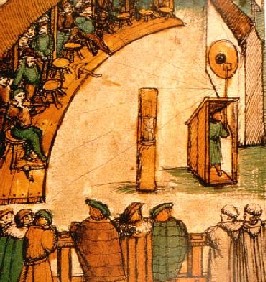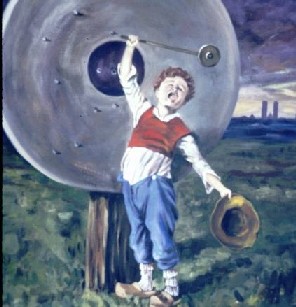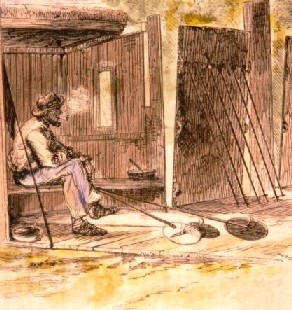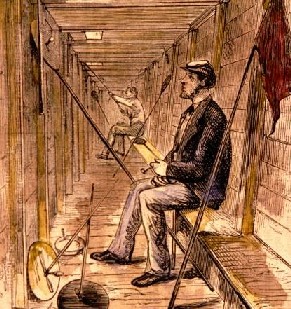Pit pulling or target marking duty has been a part of target shooting for at least 500 years, but it is only very recently that shooters have had to pull their own targets. Placing target markers down range, by the targets, so they could mark shots without interrupting shooting and having the shooters themselves walk down range was a practical development, especially when crossbows and rifles became accurate enough to permit shooting at longer distances.
One of the earliest records of having a target marker downrange comes from a drawing made during a Swiss crossbow shooting tournament that took place in 1504. In the drawing (top right), the target marker stands in a small wooden cabin placed next to the target. The marker looks through an opening to see where each shooter’s bolt strikes and uses a square paddle to signal the locations.
When flintlock and percussion rifles were used to shoot at circular wooden targets in 18th and 19th century German shooting clubs, a target marker was stationed near the target. Several shooters typically fired just one shot at the same target. The target marker often jumped into a hole near the target between shots. When a shot was fired, the target marker jumped out, drove a numbered wooden peg into the fresh shot hole and signaled the shot location (lower right).
Young boys were often used as target markers and were given the name, Scheibentoni (target boy). The Scheibentoni motif shown in the illustration here has appeared in several important German shooting festivals and was the pictorial theme of the 1966 World Shooting Championship in Wiesbaden, Germany.
Some of the earliest records of pit pullers in the United States come from Harpers Weekly drawings made during the famous long-range rifle matches of the 1870s and 1880s. The targets then were heavy steel plates that were whitewashed or painted to show fresh hits. There were both raised pits (top right) and sunken pits (lower right). The target marker had visual contact with the target and used round paddles to signal the location and value of each new shot.
By the time the U. S. National Matches were first held at Camp Perry, Ohio, in 1907, the new National Board for the Promotion of Rifle Practice was able to arrange for military support for the matches. The practice of having soldiers act as pit pullers and scores became well established.
Highpower rifle shooters have only had to pull targets for their fellow competitors for the last 30 years or so. The big change came in 1968 when military support for the National Matches was cancelled because of the war in Viet Nam. The modern reality is that military personnel are not likely to ever again be available to pull targets. Today’s highpower rifle shooters are destined to be their own pit pullers until an affordable, electronic target system similar to those used in Olympic and World Championship competitions is developed for highpower rifle shooting.



